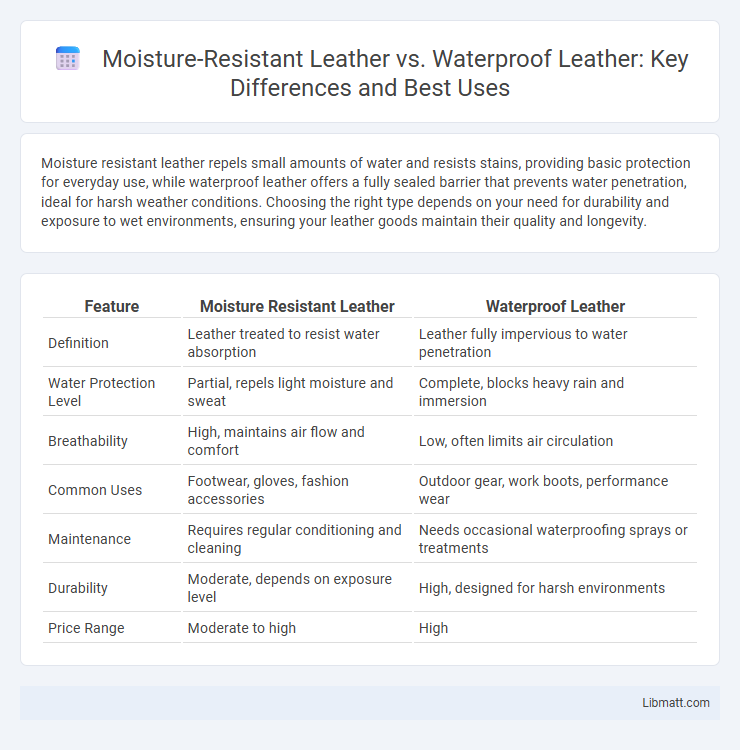Moisture resistant leather repels small amounts of water and resists stains, providing basic protection for everyday use, while waterproof leather offers a fully sealed barrier that prevents water penetration, ideal for harsh weather conditions. Choosing the right type depends on your need for durability and exposure to wet environments, ensuring your leather goods maintain their quality and longevity.
Table of Comparison
| Feature | Moisture Resistant Leather | Waterproof Leather |
|---|---|---|
| Definition | Leather treated to resist water absorption | Leather fully impervious to water penetration |
| Water Protection Level | Partial, repels light moisture and sweat | Complete, blocks heavy rain and immersion |
| Breathability | High, maintains air flow and comfort | Low, often limits air circulation |
| Common Uses | Footwear, gloves, fashion accessories | Outdoor gear, work boots, performance wear |
| Maintenance | Requires regular conditioning and cleaning | Needs occasional waterproofing sprays or treatments |
| Durability | Moderate, depends on exposure level | High, designed for harsh environments |
| Price Range | Moderate to high | High |
Understanding Moisture Resistant Leather
Moisture-resistant leather is treated to repel water under light exposure, helping to prevent surface damage and maintain the leather's texture and appearance. Unlike waterproof leather, which provides a complete barrier against water penetration, moisture-resistant leather offers breathability, allowing moisture vapor to escape and reducing the risk of mold and mildew. This balance makes moisture-resistant leather ideal for everyday use where occasional dampness is expected but full water immersion is unlikely.
What is Waterproof Leather?
Waterproof leather is specially treated to create a barrier that prevents water from penetrating the material, ensuring your footwear or accessories remain dry even in heavy rain or wet conditions. Unlike moisture-resistant leather, which can repel water to some extent but may eventually soak through, waterproof leather offers a higher level of protection by incorporating coatings, membranes, or specific tanning processes. This makes waterproof leather ideal for outdoor gear, work boots, and products designed for consistent exposure to water or harsh environments.
Key Differences Between Moisture Resistant and Waterproof Leather
Moisture resistant leather repels small amounts of water and resists dampness, making it suitable for daily wear and light exposure to moisture. Waterproof leather is specially treated and sealed to completely block water penetration, providing protection in heavy rain or submerged conditions. Your choice depends on the level of water exposure you expect, with waterproof leather offering superior protection while moisture resistant leather prioritizes breathability and comfort.
Material Composition and Treatments
Moisture-resistant leather typically features a breathable natural grain treated with water-repellent coatings such as waxes or silicone-based finishes that allow some moisture to escape while preventing surface dampness. Waterproof leather, on the other hand, involves a combination of specialized synthetic membranes like Gore-Tex laminated inside the leather or heavy-duty polyurethane treatments that create a complete barrier against water penetration. Understanding these material compositions and treatments ensures you select the right leather type for your specific environmental needs and usage conditions.
How Each Leather Type Handles Water Exposure
Moisture resistant leather repels light water exposure through surface treatment, allowing limited absorption while maintaining flexibility and breathability. Waterproof leather undergoes specialized processes such as membrane infusion or coating, creating an impermeable barrier that prevents any water penetration even under prolonged exposure. The difference lies in moisture resistant leather's ability to resist minor dampness versus waterproof leather's capacity to completely block water, making it ideal for harsher wet conditions.
Durability and Longevity Comparison
Moisture-resistant leather offers moderate protection by repelling water to prevent surface damage, extending the material's durability under everyday conditions. Waterproof leather provides a higher level of defense by blocking water penetration entirely, significantly enhancing longevity even in harsh or wet environments. Over time, waterproof leather typically outperforms moisture-resistant leather in maintaining structural integrity and appearance, making it ideal for prolonged exposure to moisture.
Best Uses for Moisture Resistant Leather
Moisture resistant leather is ideal for everyday items like shoes, bags, and jackets that encounter occasional dampness but not prolonged exposure to water. It offers protection against light rain and sweat, maintaining durability and breathability for outdoor activities or casual wear. Your best use of moisture resistant leather is in products designed for comfort and moderate weather conditions without full waterproof requirements.
Ideal Applications for Waterproof Leather
Waterproof leather is ideal for applications requiring complete protection from water exposure, such as outdoor footwear, marine gear, and work boots in wet environments. This type of leather uses specialized treatments and membranes to prevent water penetration, ensuring durability and comfort in heavy rain or submerged conditions. Its performance makes it highly suitable for hiking boots, motorcycle gear, and water sports accessories where moisture resistance alone is insufficient.
Maintenance Requirements: Moisture Resistant vs Waterproof
Moisture-resistant leather requires regular conditioning and cleaning to maintain its protective layer and prevent damage from humidity, while waterproof leather demands more intensive sealing treatments to ensure full water impermeability. Your maintenance routine should include drying leather slowly after exposure to moisture to avoid stiffness and cracking in both types, but waterproof leather often benefits from specialized sprays or waxes to reinforce its barrier. Choosing between the two depends on your willingness to perform consistent upkeep versus investing in advanced waterproofing products.
Choosing the Right Leather for Your Needs
Moisture resistant leather offers moderate protection by repelling light water exposure while maintaining breathability, making it ideal for everyday use and casual wear. Waterproof leather provides a complete barrier against heavy rain and prolonged water contact, ensuring durability and performance in extreme conditions. Selecting the right leather depends on your lifestyle needs, with moisture resistant leather suited for comfort and style, and waterproof leather preferred for outdoor activities or wet environments.
Moisture resistant leather vs waterproof leather Infographic

 libmatt.com
libmatt.com